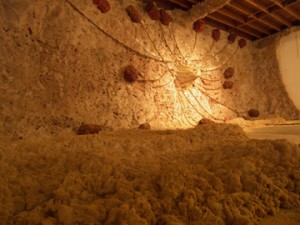« Editor's Picks
Magnús Árnason: Polymorph

Magnús Árnason. Polymorph. 2007. Site specific installation at Locust Projects, Miami. Mixed media. Photo Courtesy Jose E. Lopez
Modern man is accustomed to internalizing artistic creation through experience. For the last few decades, we have approached works of art not as passive observers, but as participants. (1) In fact, in the last few years exhibition and museum techniques have evolved into concepts which try to actively involve the spectator in particular environments, so that he, as a result of the experience, can come to know and interact with the context in which the conceptual and material creation of the work of art evolved. Thus, through the use of colors, textures, lighting, tactile and motor senses, sounds and smells; the museum visit becomes a memorable personal experience.(2)
The Icelandic artist, Magnús Árnason (1977), develops his work based on dialogue, on the direct interaction of the observer with the piece, with experience being the fundamental method of absorbing certain phenomena. He recently debuted on the Wynwood District art scene with his piece, Polymorph, exhibited at the Locust Project. It is an impressive installation which recreates the atmosphere of a dark cavern full of secretions, earth and rocks, in which a rare organic species seems to take shape. Strange sounds are mixed with kinetic sculptures and archaic forms which remind us of fertility symbols, drenched in vital fluids. The walls, covered with mud, display a cryptic system of symbols stamped in a sticky substance resembling blood. From the ceiling hang elongated structures which like butterfly cocoons shelter little creatures enveloped in mucus, which emit almost imperceptible wails, in a theatrical format reminiscent of a Death Metal performance or a horror film. With incredible skill and sage handling of materials, Árnason recreates imaginary spaces that never existed or maybe they did, at the inception of terrestrial life. His ambiences reside in his psyche; they are spaces he believes he has visited in his readings or mental journeys.
At first, information used to interpret this work appears dark, but little by little instinct and memory begin guiding our perception. A dialogue then takes place at a sensory level, between the piece and the subconscious of the observer who uncovers paths to interpretation. Umberto Eco in his masterpiece, “Opera aperta” (Open work), first published in 1962, spoke of “the unfinished work that the author appears to deliver to the interpreter more or less like Meccano pieces, in apparent disinterest of how things will turn out.”(3) In this type of work, the viewer becomes the coauthor by putting the piece in contact with the outside world, deciphering and interpreting its peculiarities in order to add his contribution to the creative act. Polymorph presents itself as terrain open to suggestion, interpretation and reinterpretation. It is only complete once the spectator looks at it and is amazed, moved, disturbed, suffocated, trapped, frightened and awed by its presence.
Árnason, for his part, prefers to not provide any further details regarding his work. In a recent interview he stated: “I don’t have any certain message that I am trying to give out. It is more about creating an uncertain atmosphere that is free for individual interpretation.”(4) He says no more because he does not want art critic reviews to lead the spectator down a predetermined path. He well knows that only the non-explicit is truly analyzed. He does not want to tame a person’s interpretation of his work; he does not want to condition it by revealing his intentions, ideas, likes or specific details about his personality. He prefers to have the piece finish constructing itself through the personal experience of the viewer.
The artist forces the person confront his phobias, fears and loathings through disconcerting scenes which range from the magical to the nightmarish. He toys with a public anxiously trying to decipher what the artist is attempting to say, what dark symbolism is contained in the structures. In this way, he makes us approach his work with a voyeuristic predisposition, the pleasure of exploring and approaching a place that was up until now off limits to us. It is perhaps like entering his mind and feeling we have been there. We experience the vague certainty of knowing that space and then suddenly feel terrified at the thought of being trapped inside. We listen to the strange noises emitted by that barely nascent being and feel a deep tenderness mixed with a visceral fear that the strange creature will turn against us.
Polymorph has an implicit grotesque, strange and enthralling beauty. It is presented as a unique experience which exists only in a specific place and time. Even if the artist dismantles it and takes it somewhere else, attempting to perpetuate every detail, the staging will never be the same. The public’s comprehension of the work will never be the same. Thus, what we can take away with us or retain is not the object itself so much as our experience in the presence of the object.
Magnús Árnason, also known for his dark, enigmatic performances, has studied at Hafnarfjördur (Iceland) and at the Akademie der bildenden Künste, Vienna (Austria). He has exhibited his works in Reykjavík, Vienna, Berlin, Bratislava (Slovakia) and Turin. In 2005 he participated in T1 Torino Triennale Tremusei, Turin (Italy). Polymorph, on display at Locust Project from July 14 through August 31, 2007 was his first solo exhibition in the United States.
1 Conceptual art, rendered in installations, performances, happenings, body art, video art, etc., converts the artistic experience into a scenario in which the observer can actively participate.
2 Zavala, Lauro. Posibilidades y límites de la comunicación museográfica. México, Universidad Nacional Autónoma de México, 1993.
3 Eco, Umberto. Obra abierta. Editorial Planeta, 1984, p. 74.
4 Author’s interview with Magnús Árnason, July 2007.


































